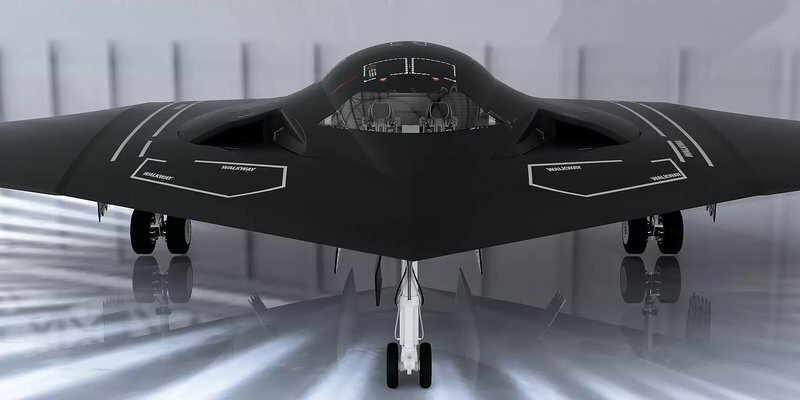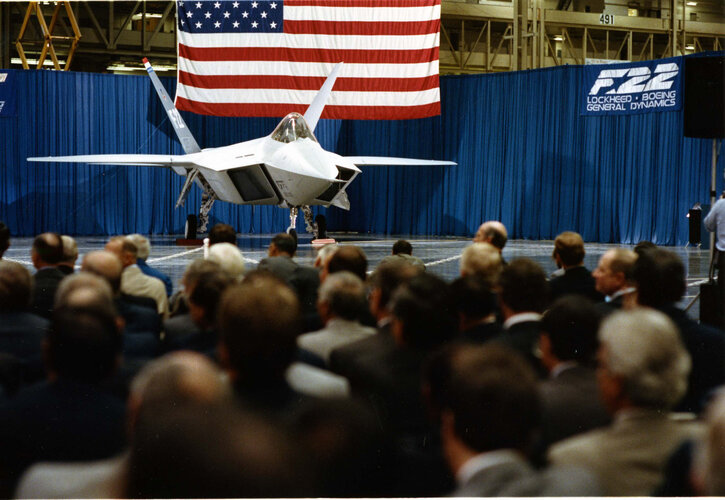Well its definitely not going to be a alcm sized launched decoy from the weapons bay for many practical reasons. I admit a b21 airframe is a stretch but considering each b21 is a national asset..... It will result in something with long legs and long persistent time over enemy airspace. It will be first in and last out until the raider has left. This means its going to be relatively large and probably tanking up 1000+ miles from the battle space, so yes autonomous refueling
You are using an out of date browser. It may not display this or other websites correctly.
You should upgrade or use an alternative browser.
You should upgrade or use an alternative browser.
Northrop Grumman B-21 Raider (LRS-B)
- Thread starter TomS
- Start date
aonestudio
I really should change my personal text
- Joined
- 11 March 2018
- Messages
- 2,964
- Reaction score
- 7,485

Meeting the B-21 Raider: 2022 to bring new bomber’s eagerly awaited rollout
Next year will also bring what are expected to be tough choices and retirements as part of the upcoming budget proposal for FY23.
FighterJock
ACCESS: Above Top Secret
- Joined
- 29 October 2007
- Messages
- 5,597
- Reaction score
- 5,925

Meeting the B-21 Raider: 2022 to bring new bomber’s eagerly awaited rollout
Next year will also bring what are expected to be tough choices and retirements as part of the upcoming budget proposal for FY23.www.defensenews.com
Personally I cannot wait to see the B-21 Raider getting rolled out next year, only thing is when it will happen.
An F-15 was filmed air launching variant of UTAP-22s that appears to have a FLIR and missile warning equipment. I don’t think air launch from an ALCM form factor completely out of reach, as long as you were ok with the UAV being disposable or having to be recovered from a forward base. Rocket launch and parachute recovery would also be an option in that weight class. If the loyal wingman has to have the same range as a B-21, you’re going to need a much larger UAV which is going to rapidly drive up costs. In flight refueling might be an option though I haven’t heard of any tests in that direction.Well its definitely not going to be a alcm sized launched decoy from the weapons bay for many practical reasons. I admit a b21 airframe is a stretch but considering each b21 is a national asset..... It will result in something with long legs and long persistent time over enemy airspace. It will be first in and last out until the raider has left. This means its going to be relatively large and probably tanking up 1000+ miles from the battle space, so yes autonomous refueling
FighterJock
ACCESS: Above Top Secret
- Joined
- 29 October 2007
- Messages
- 5,597
- Reaction score
- 5,925
Excuse me, if this already was discussed, but what's this? Some sort of fan-art or speculation? Or a scale model of the real thing?
View attachment 670307
Quite possibly fan-art just like you might find over at the H-20 thread Scar, I have become extremely wary about pictures that claim to be like wise. Personally I would wait until the real thing gets revealed in the new year.
I tend to agree. I'm very cautious towards all these pics, just wanted to ask to be sure i didn't miss something.Quite possibly fan-art just like you might find over at the H-20 thread Scar, I have become extremely wary about pictures that claim to be like wise. Personally I would wait until the real thing gets revealed in the new year.
- Joined
- 1 April 2006
- Messages
- 11,375
- Reaction score
- 10,209
Excuse me, if this already was discussed, but what's this? Some sort of fan-art or speculation? Or a scale model of the real thing?
Bad fanart. I always wonder why people who has time to learn 3ds Max and for creating these renderings, wouldn't spent some more on reading some basic aircraft design textbook and studying some white world references. So many efforts wasted.
Aircraft 3D Models | CGTrader
Various models of 3D aircraft such as planes as well other flying military and commercial vehicles will help your projects take off and land safely.
www.cgtrader.com
Oh, thank you for making things completely clear, Flateric.Bad fanart. I always wonder why people who has time to learn 3ds Max and for creating these renderings, wouldn't spent some more on reading some basic aircraft design textbook and studying some white world references. So many efforts wasted.
From the article above I'm confused about the quote below.
Is that regarding info before the public unveiling or will there simply not be a traditional unveiling? Perhaps a small snippet and that will be it?
“You’re not going to get to see much of it,” Kendall said during an online Defense One panel. “We don’t want to give our enemies a head start on any of this. We’re going to acknowledge that we’re doing this, let the public be aware, let the Congress be aware of it. But we’re not going to say a lot more about what we’re doing in the public.”
Is that regarding info before the public unveiling or will there simply not be a traditional unveiling? Perhaps a small snippet and that will be it?
Last edited:
The latter yeah. Pehaps a look from far away, out if the hangar, of a plane within a hangar. With bad lighting. That's the most I dare to hope for the unveiling. And it will likely remain that way for a few more years.
I expect the exhaust arrangement at a minimum to be very closely guarded. The B-2 was the same way; you never saw pictures from rear arc. I think the B-2s details were declassified more because of the complete lack of peer competitors rather than time passing or the technology becoming obsolete. I think B-21 details will be obscured for decades.
In actual flight they will get observed…but I bet no close photos are ever released from the rear angle. It seems likely the exhaust is dorsally mounted which make observations from the ground difficult.
I think you some of you guys are making a big to-do over the shape of the exhaust when the real secrets are in the unseen engineering that goes into it.
Think about the sr71 and the engine spikes. Putting a spike on an inlet doesn't magically make thrust. There is a lot of physics needed to make it work
Think about the sr71 and the engine spikes. Putting a spike on an inlet doesn't magically make thrust. There is a lot of physics needed to make it work
From memory at the B-2s public reveal it was parked against a hanger but an aviation magazine hired a helicopter and got photos of the exhaust anyway.
Anyone got a link to the story? I can't find it anymore, anyone wanna get a drone or two ready?
Anyone got a link to the story? I can't find it anymore, anyone wanna get a drone or two ready?
- Joined
- 1 April 2006
- Messages
- 11,375
- Reaction score
- 10,209
1988: B-2 Stealth Unveiled | Aviation Week Network
An Aviation Week editor overcame U.S. Air Force efforts to keep the B-2's stealth features secret by literally going over everyone's heads at the bomber's rollout.
- Joined
- 21 January 2015
- Messages
- 12,137
- Reaction score
- 16,299
Exactly people are too concentrated on the external and not the internal. I believe parts of the B-2s internals are still classified.I think you some of you guys are making a big to-do over the shape of the exhaust when the real secrets are in the unseen engineering that goes into it.
Think about the sr71 and the engine spikes. Putting a spike on an inlet doesn't magically make thrust. There is a lot of physics needed to make it work
- Joined
- 21 January 2015
- Messages
- 12,137
- Reaction score
- 16,299
You ever met aircraft spotters and some of their camera setups. Even an aircraft in flight is still not safe from their lenses. Once they are in active service especially if they come to the UK they will be photographed. Plus I am pretty certain within six months of its unveiling they’ll be diecast models on sale.In actual flight they will get observed…but I bet no close photos are ever released from the rear angle. It seems likely the exhaust is dorsally mounted which make observations from the ground difficult.
1- they may have planned for this, maybe a retractable cover, built in - IF the exhaust has a feature the chinese are not already aware of....
2- it could be the material, or the small scale aerodynamics that are special, so unless someone is let loose with a micrometer, and a few hours/or a wind tunnel, it may not be visible/detectable.
3- to prevent 1988 again, they will actually cover up the sensitive areas, or maybe a swirly pattern, like the car makers use.
2- it could be the material, or the small scale aerodynamics that are special, so unless someone is let loose with a micrometer, and a few hours/or a wind tunnel, it may not be visible/detectable.
3- to prevent 1988 again, they will actually cover up the sensitive areas, or maybe a swirly pattern, like the car makers use.
FighterJock
ACCESS: Above Top Secret
- Joined
- 29 October 2007
- Messages
- 5,597
- Reaction score
- 5,925
1- they may have planned for this, maybe a retractable cover, built in - IF the exhaust has a feature the chinese are not already aware of....
2- it could be the material, or the small scale aerodynamics that are special, so unless someone is let loose with a micrometer, and a few hours/or a wind tunnel, it may not be visible/detectable.
3- to prevent 1988 again, they will actually cover up the sensitive areas, or maybe a swirly pattern, like the car makers use.
I think that to prevent 1988 from happening again the USAF should put up a couple of fighters up as well as shutting the airspace around Edwards AirForce base during the B-21 roll out.
I have a hard time believing the alleged story of the innocent flyby. Things might have seen some drastic changes since then, but every flyer here should realize that NOTAMS are routinely barring us from flying here and there.
In my imagination, someone in the Reagan administration realized the potential to subjugate voters with those futuristic shapes and wanted to advert the vented effect from the miserable cropped picture of the Wobblin Goblin released earlier.
I do believe that we will see a lot from day one. What it does, how it can do it will remain classified.
In my imagination, someone in the Reagan administration realized the potential to subjugate voters with those futuristic shapes and wanted to advert the vented effect from the miserable cropped picture of the Wobblin Goblin released earlier.
I do believe that we will see a lot from day one. What it does, how it can do it will remain classified.
- Joined
- 16 April 2008
- Messages
- 9,601
- Reaction score
- 14,480
Reading about Dornheim and the B-2 rollout, I very much believe that someone screwed up the NOTAM so that it only prevented flights arriving or departing from Palmdale, not overflights.
IIRC, they tried to get Dornheim's pilot's licence revoked before they realized that he hadn't actually busted the terms of the published NOTAM.
If the Reagan administration had wanted to release an overhead shot of the B-2, they could have just done it. No need to hope someone spotted a subtle mistake and took advantage of it.
IIRC, they tried to get Dornheim's pilot's licence revoked before they realized that he hadn't actually busted the terms of the published NOTAM.
If the Reagan administration had wanted to release an overhead shot of the B-2, they could have just done it. No need to hope someone spotted a subtle mistake and took advantage of it.
RavenOne
ACCESS: Top Secret
- Joined
- 18 June 2008
- Messages
- 1,003
- Reaction score
- 2,675
That was like the F-117 I saw at the '96 Reno races, it was in a darkened hanger which was surrounded by troops standing shoulder to shoulder. You couldn't see very much at all.
First time I saw the F-117A was at 1996 RAF Mildenhall Air Fete and you could see plenty so here are my photos. It was not the first Air Fete that it appeared as think it appeared at 92 or 93 o4 94.
Its first airshow appearence outside usa was Paris Air Show 1991...
cheers
Attachments
R1, they did eventually drag the aircraft out on the last Sunday of the race week. It was going to do a flight display but it was cancelled because the wind was too bad. I've got a photo of it somewhere, taken on my old Olympus OM-10.
jsport
what do you know about surfing Major? you're from-
- Joined
- 27 July 2011
- Messages
- 7,720
- Reaction score
- 5,732

2020-12 | The Aerospace Advantage
The Mitchell Institute for Aerospace Studies is proud to present The Aerospace Advantage, with former Air Force weapons school instructor and Thunderbird Lt Col (ret) John “Slick” Baum as the host. Every week, Slick will take listeners into the world of ae...
around the 30:00 the General starts to elaborate how far behind the AF is behind on Pac.
The few Raiders that will be build are not poised to effect much and therefore under current cost constraints what is the outcome capability vs the need for capacity. Minus a 900B to 1T budget alternatives need a look.
- Joined
- 2 August 2006
- Messages
- 3,255
- Reaction score
- 1,527
Actually, you got it backwards, that grainy, fron quarter photo was a brilliant way to unveil it. It was their way of unveiling the F-117A without revealing too much information about it. I mean, I knew it was longer than was shown in those early crappy drawings by people who don't understand anything about aircraft and how they are designed and operate. But if you know how long it is, you can determine all of it's actual dimensions and determine it's capabilities as a result, in terms of range, etc. But that bad picture, without any reference dimensions made it difficult to determine anything about the airplanes performance, so it was a way of making it known without revealing too much information.I have a hard time believing the alleged story of the innocent flyby. Things might have seen some drastic changes since then, but every flyer here should realize that NOTAMS are routinely barring us from flying here and there.
In my imagination, someone in the Reagan administration realized the potential to subjugate voters with those futuristic shapes and wanted to advert the vented effect from the miserable cropped picture of the Wobblin Goblin released earlier.
I do believe that we will see a lot from day one. What it does, how it can do it will remain classified.
The USAF did the same thing when they rolled out the YF-23. Most of the pics were from the front or front quarter and as usual, most of the concept artists got the proportions and planform wrong. I remember figuring it out by looking at the size of the concrete squares and the shadow to get the basic size and shape of the planform. Having said that, the only thing we were unable to determine until more was revealed with flight testing was the size/shape/actual location of the nozzles.
- Joined
- 1 April 2006
- Messages
- 11,375
- Reaction score
- 10,209
There are dozens YF-23 roll-out photos that were made from side on June 22, 1990. A week later Northrop released official 3-view (not talking about EMD version 3-view even showing missile carriage occasionally distributed to some journos in a press-pack handouts on roll-out day).
The USAF did the same thing when they rolled out the YF-23. Most of the pics were from the front or front quarter and as usual, most of the concept artists got the proportions and planform wrong. I remember figuring it out by looking at the size of the concrete squares and the shadow to get the basic size and shape of the planform. Having said that, the only thing we were unable to determine until more was revealed with flight testing was the size/shape/actual location of the nozzles.
- Joined
- 2 August 2006
- Messages
- 3,255
- Reaction score
- 1,527
Thanks, I don't recall seeing those, but I trust you.There are dozens YF-23 roll-out photos that were made from side on June 22, 1990. A week later Northrop released official 3-view (not talking about EMD version 3-view even showing missile carriage occasionally distributed to some journos in a press-pack handouts on roll-out day).
The USAF did the same thing when they rolled out the YF-23. Most of the pics were from the front or front quarter and as usual, most of the concept artists got the proportions and planform wrong. I remember figuring it out by looking at the size of the concrete squares and the shadow to get the basic size and shape of the planform. Having said that, the only thing we were unable to determine until more was revealed with flight testing was the size/shape/actual location of the nozzles.
Vahe Demirjian
I really should change my personal text
- Joined
- 28 February 2013
- Messages
- 815
- Reaction score
- 570
I don't think any pilot will fly over the grounds of Plant 42 where the B-21 rollout ceremony is to be held. Maybe the B-21 rollout ceremony could be held indoors, as was done with the A380.1- they may have planned for this, maybe a retractable cover, built in - IF the exhaust has a feature the chinese are not already aware of....
2- it could be the material, or the small scale aerodynamics that are special, so unless someone is let loose with a micrometer, and a few hours/or a wind tunnel, it may not be visible/detectable.
3- to prevent 1988 again, they will actually cover up the sensitive areas, or maybe a swirly pattern, like the car makers use.
I think that to prevent 1988 from happening again the USAF should put up a couple of fighters up as well as shutting the airspace around Edwards AirForce base during the B-21 roll out.
FighterJock
ACCESS: Above Top Secret
- Joined
- 29 October 2007
- Messages
- 5,597
- Reaction score
- 5,925
I don't think any pilot will fly over the grounds of Plant 42 where the B-21 rollout ceremony is to be held. Maybe the B-21 rollout ceremony could be held indoors, as was done with the A380.1- they may have planned for this, maybe a retractable cover, built in - IF the exhaust has a feature the chinese are not already aware of....
2- it could be the material, or the small scale aerodynamics that are special, so unless someone is let loose with a micrometer, and a few hours/or a wind tunnel, it may not be visible/detectable.
3- to prevent 1988 again, they will actually cover up the sensitive areas, or maybe a swirly pattern, like the car makers use.
I think that to prevent 1988 from happening again the USAF should put up a couple of fighters up as well as shutting the airspace around Edwards AirForce base during the B-21 roll out.
Then what is the point of calling it a rollout ceremony if it is to be held indoors?
FighterJock
ACCESS: Above Top Secret
- Joined
- 29 October 2007
- Messages
- 5,597
- Reaction score
- 5,925
Thanks for that sferrin, I had forgotten about the YF-22 rollout did not take place in the open air, but one oddball about the ATF program was that the YF-23 was rolled out in the traditional way.
Last edited by a moderator:
X-39
To post or not to post, that is the question
- Joined
- 20 February 2021
- Messages
- 382
- Reaction score
- 928

Getting the most out of AUKUS could require Plan B-21 | The Strategist
As the Defence Department’s deputy secretary for strategy between 2009 and 2012, I asked US counterparts on three occasions about the likelihood they would share submarine nuclear-propulsion technology. The answer was the same each time: ...
21 Jan 2022|Peter Jennings
As the Defence Department’s deputy secretary for strategy between 2009 and 2012, I asked US counterparts on three occasions about the likelihood they would share submarine nuclear-propulsion technology.
The answer was the same each time: there was no way the US Navy or Department of Energy would hand Australia the technology. Britain had been given access in 1958 under conditions where even today the US has stringent oversight of its capability, but that was the limit of American openness.
The American judgement was that we should stick to our quiet conventional submarines, which the US military valued highly.
Two things have changed since then: first, communist China presents a near-term existential threat to the global strategic balance; and second, Joe Biden is US president. The China threat will outlast Biden, but the key question for Australia is: will AUKUS survive a change of president?
Without Biden’s intervention, America’s nuclear-propulsion bosses would not have changed their minds about Australian access.
On Monday, The Australian reported the views of Randy Schriver, a respected assistant secretary of defence in the Trump administration, that there were ‘many potential obstacles on both sides’, including pushback from the US Navy. Success requires ‘sustained commitment from the senior political leaders in both capitals, otherwise the chances of Australia deploying its own nuclear submarine will drop below 50 per cent’.
Schriver backs AUKUS but says that, even with Biden’s personal support, a successful transfer of propulsion technology is a 50–50 proposition.
I want AUKUS to succeed, just as I wanted the French-designed Attack-class submarines to be a triumph. Australia needs a defence force with excellent technology, able to deter a well-armed enemy, and submarines can play that role.
Australia needs to persuade the US that we are serious about taking on nuclear propulsion, that we will spend the money, recruit the people, design the safety systems, build the ports, and train and exercise the navy to be outstanding nuclear custodians. On the AUKUS timeframe announced last September, we have until February 2023 to develop ‘an optimal pathway to deliver this capability’. Thirteen months to go.
By February 2023 Australia could have a different government, one more doubtful about nuclear propulsion. Boris Johnson’s attempt to hang on to the UK prime ministership, optimistically titled ‘Operation Save Big Dog’, may have sunk well before 2023.
Biden could face a Republican-controlled Congress after the November 2022 midterm elections, constraining his ability to make bold executive decisions.
Just like the Attack-class submarine project, it may emerge that the technology on offer is ultimately not going to deliver what Australia needs. Or it may be unaffordable or too far into the future to matter, or, as the US Navy worries, beyond what our navy of 16,000 people can handle.
It took half a decade for our government to conclude that it needed a Plan B to escape from the Attack-class project. Does anyone seriously think we should approach AUKUS as though nothing could go wrong?
Even if AUKUS delivers success in other technology areas like cooperation on hypersonic missiles, nuclear propulsion is a risky centrepiece for the grouping. A failure of AUKUS is something we cannot allow to happen because it would strengthen Beijing’s claim that American decline in the region is inevitable.
To keep AUKUS strong, and for our own security, we need a Plan B if nuclear propulsion fails. Given our geography, Australia needs military equipment with range and hitting power. Nuclear-powered submarines provide unlimited range but with constrained firepower—it’s a long way back to port once the limited stock of torpedoes has been fired.
Extended-range strike aircraft give more flexibility and the capacity for faster missile replenishment. Australia should look at options to join with the US in acquiring the long-range B-21 stealth bomber. The aircraft’s development is complete. Five aircraft are in construction in California; initial flights have already happened, with more planned in the next few months.
No one piece of equipment changes the strategic balance, but long-range stealthy strike aircraft would complicate Beijing’s offensive plans, creating a barrier to military adventurism. Raising the barrier to military conflict is what is needed in the next few years.
ASPI’s Marcus Hellyer points out that the B-21 will use two F-35 engines but have three or four times the unrefuelled range. The US Air Force plans for a unit price under $1 billion, which is an astonishing amount of money until you compare it with the $45 billion we plan to spend on future frigates, $89 billion on submarines and $30 billion on armoured vehicles.
Australia operated the F-111 long-range strike bomber until December 2010, so this is a type of machinery we have mastered in the past. AUKUS gives us an opportunity to see if we can buy into a game-changing technology, with production starting soon, delivering a long-range stealth weapon that will reinforce deterrence in Asia.
The Royal Australian Air Force could be operating this aircraft within half a decade, making it relevant to the current strategic situation.
An investment now will spend money that can’t be spent on submarine construction at least for a decade and overcome a lack of hitting power in the Australian Defence Force.
Strike capability will make the ADF a much more difficult opponent and thereby strengthen deterrence. That means keeping the region at peace.
The case against the B-21 bomber is that it isn’t in Defence’s current plan and won’t be built in Adelaide. This points to weaknesses in how we acquire military technology: our processes are too slow and too focused on incrementally adding to the existing design of the ADF. We need more creativity.
Left to its own devices, it would take Defence years to decide that a stealthy strike bomber might be worth buying. At Christmas, The Australian reported that a review of Defence innovation planned ‘major reforms’ to ‘get new projects to contract stage’, cutting ‘as much as 12 months from the current four years’.
Four years is longer than the time between the attack on Pearl Harbor and the end of the war in the Pacific. Defence is talking the language of a strategic crisis but hasn’t yet worked out how to break out of a peacetime acquisition mindset.
AUKUS provides the best platform we have to think again about the design of the defence force. This will only happen with ministerial push. There is literally no time to lose.
Oh really?? Wasn't the first flight scheduled to happen months after the rollout, in Q3 or Q4 2022? And i doubt USAF would make their new toy available for export as soon as they get theirs. More like The
Similar threads
-
USAF to Retire B-1, B-2 in Early 2030s as B-21 Comes On-Line
- Started by flateric
- Replies: 323
-
-
-
-








